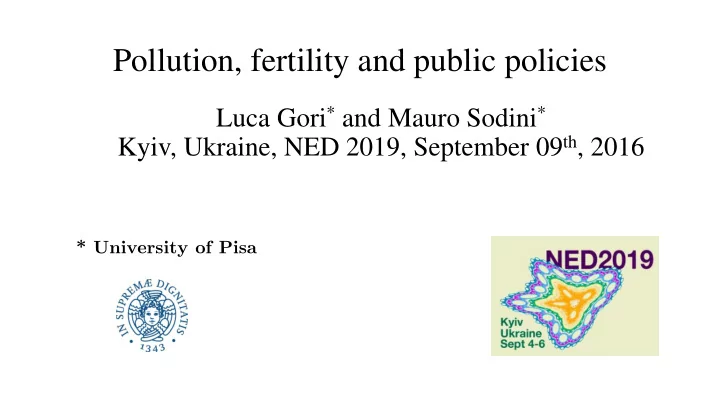

Pollution, fertility and public policies Luca Gori * and Mauro Sodini * Kyiv, Ukraine, NED 2019, September 09 th , 2016 * University of Pisa
Motivations • Micro and Macro founded model to study the relationship between (some) economic and environmental variables; • Understand different development regimes; • Study possible determinants of poverty traps of take-off.
Possible linkages between economic and environmental variables (Caravaggio and Sodini 2018, Frontiers in Applied Mathematics and Statistics) • Environment may be a (private or public) productive input in the production function (Antoci et al., JET 2011 and Caravaggio and Sodini, CNSNS, 2018); • Environment may be a good entering the utility function (John and Pecchenino (1994), Antoci and Sodini, CSF 2009, Antoci et al. FJAM 2010, Antoci et al. Nonlinear Dynamics in Economics, Finance and the Social Sciences, 2010, Antoci et al. CNSNS, 2016); • Climate change and Maladaptation (Antoci et al., EDE, 2019); • Environment may affect the life-expectancy (Raffin and Seegmuller 2014).
• Intertemporal externalities (OLG model); • Externalities in the optimization problem;
Changes in life-expectancy may produce changes in • Saving; • Fertility choices; • Consumption; • Investment in human capital. This issue has been recently explored for HIV epidemics (Gori et al., MD 2019, Gori et al., forthcoming, Gori et al. WP)
Unified growth theory • Basic elements: life-expectancy, fertility, physical and human capital accumulation are studied in a unique model with simple specifications that make the analysis possible. • De la Croix and Doepke (2003) study a model where transition between phases is driven by heterogeneity between agents. • Yakita (2010) introduces a simplified framework where different unexplored issues may be studied.
The model Utility function n t is the number of children; C t+1 is the private (old-age) consumption; h t+1 is the human capital of the offspring;
The model Constraints
Agent’s problem KKT conditions
Agent’s problem (I) Solution of the optimization problem
Agent’s problem (II) Solution of the optimization problem
Life-expectancy
Life-expectancy
Pollution Dynamics
Public expenditure
Production and prices
Population Dynamics
Market Equilibrium Conditions
Equilibrium Dynamics
According to the different regimes we have:
Equilibrium Dynamics (First Stage)
Equilibrium Dynamics (Second Stage)
Preliminar results • Multiple attracting fixed points; • The mix of policies may be determinant in defining the trajectories of the economy • Changes of policies driven by environmental target may change the long run dynamics • Cycles?
Thank you
Recommend
More recommend